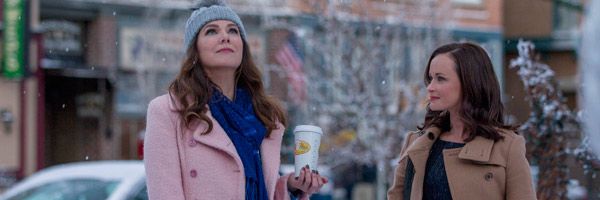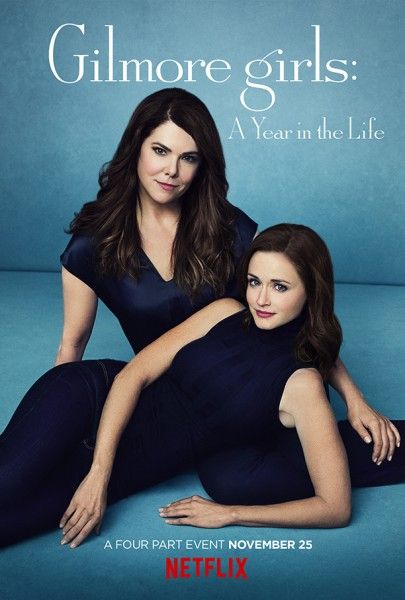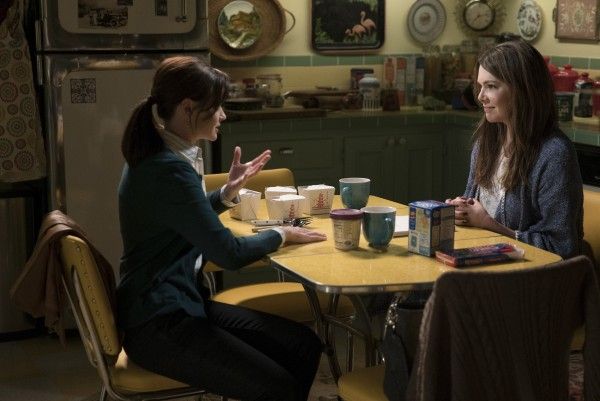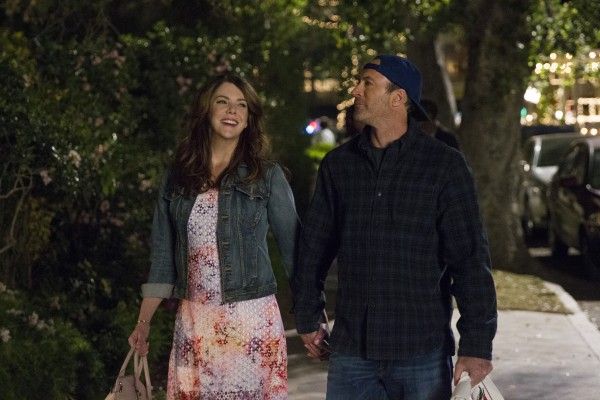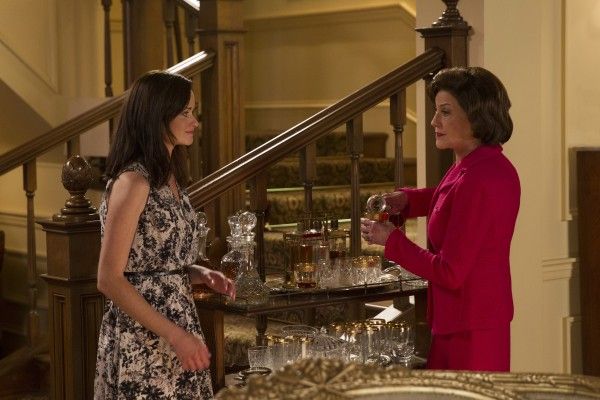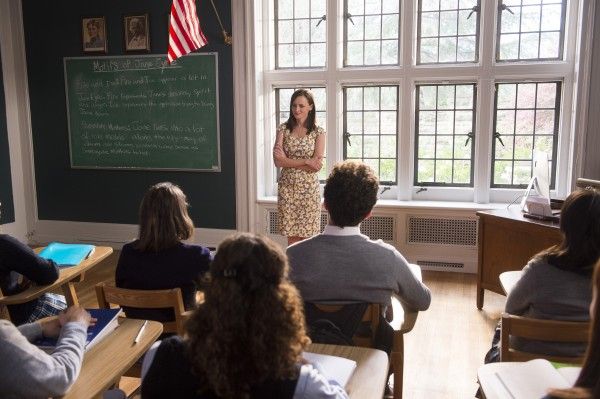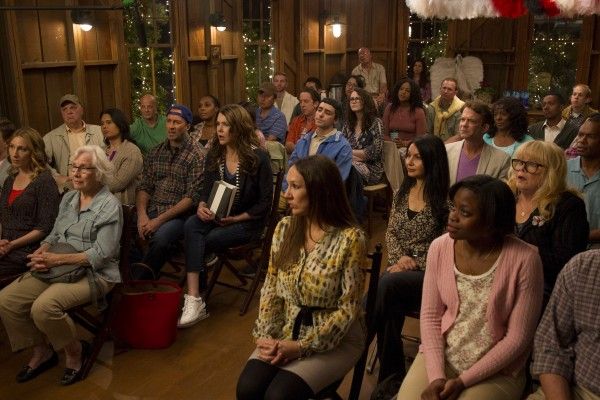Written, directed and executive produced by series creator Amy Sherman-Palladino and executive producer Daniel Palladino, the four-part Netflix series Gilmore Girls: A Year in the Life brings back countless favorites from the original series, including, of course, Lauren Graham (as Lorelai Gilmore), Alexis Bledel (as Rory Gilmore), Kelly Bishop (as Emily Gilmore) and Scott Patterson (as Luke Danes) while also paying tribute to actor Edward Herrmann (who played Richard Gilmore on the original series), who died in 2014. A true gift to the fans that have supported the series and felt like it deserved the chance to end on its own terms, Stars Hollow has been fully restored in all its glory, from Luke’s Diner to the Dragonfly Inn to Lorelai’s charming Connecticut home.
During this roundtable interview to discuss these four new 90-minute episodes, co-stars Lauren Graham and Alexis Bledel talked about taking time for nostalgia, how surreal it was to return, why this show has such an enduring appeal, the big reunion, why Lorelai and Rory’s journey seems like a natural progression, what they enjoy about working with each other, and their favorite aspects of the original series.
Collider: Was there any time for nostalgia with this, or did you have to get right back to work?
LAUREN GRAHAM: It was all nostalgia and back to work, which was nostalgic, in its own way.
ALEXIS BLEDEL: There’s definitely time for nostalgia.
How did it feel to return?
BLEDEL: Surreal. A little bit like we never left. It was exciting to be back and get this chance to revisit something that was really dear to all of us and that we spent a lot of time on.
GRAHAM: You never get to start something already feeling the love. Never, unless you’re in Star Wars 5, but even then, it’s up in the air, which way they’ll go. People were happy to be working on the show, if they hadn’t been there before. If they had, they were happy to be back. We had a positive perspective on the opportunity we’d been given. There was a lot of buoyancy, and that helped us get through. This is a challenging show to do. These are long scenes and long speeches with theatrical language, and that’s not what most TV is. I hit a point, about half-way through, where I was like, “I remember you.” I had this feeling where I was delirious. But, it’s different to know there’s an end in sight. The overwhelming feeling was gratitude.
After being on this show for so long, what was it like to transition into other projects?
GRAHAM: I couldn’t understand why we’d be done so early on Parenthood. It’s why I wrote a book. I was like, “What am I supposed to do now? It’s 3 o’clock.” I honestly didn’t get that there was another way to do a one-hour drama. It took me years, transitioning out of that show. I did a musical and I went and did a couple of movies, but it stuck with me for a long time, maybe even until starting Parenthood. It was our whole lives, for that time, with good times and tougher times. It’s like going to medical school, I’d imagine. But that’s all life is, transitioning from one thing to the next. Had we made a movie right after, we would have liked it, but this was pretty special.
BLEDEL: Having the time between the end of the series and the beginning of these episodes really gave us a lot of perspective on what this show meant to people and what it means for us, creatively. It did take me awhile to get this character out of my system, as well. I didn’t even know how to go about doing that ‘cause it was my first job and it went on for so long, which was incredibly fortunate. I tried to play as many different characters as I could and reach as far as I could, sometimes in strange directions. I was just trying to play characters that were as different as I would be allowed. That’s an important thing for an actor to do because then you learn what your wheelhouse is. You have to discover that. You can’t learn it any other way besides trying different things. I think I’m honing in on that. But, it was fun to play different characters and work with different directors. Working on Mad Men was an incredible experience. It was such an incredible show with beautiful writing and so much complexity. Coming back to this character, she had grown up. It was interesting that we get to go back to the characters in real time because I had grown up the same amount, but in a very different environment. Getting to think about her and where she’s been, doesn’t happen very often. It’s happening more and more now, that people get this opportunity.
Why do you think this show has such an enduring appeal?
GRAHAM: I think people appreciate that [small town] aspect of it. I start to sound like old lady Jackson when I’m like, “There’s nothing soothing to watch. I don’t want to watch this violence.” But I don’t want that, all the time. And I don’t want reality TV to be our only option, as an actor. I think there are a number of reasons why the show has stuck around, but at the end of the day, there’s something to be said for something you want to watch with a family member or friend, and that isn’t too stressful, but still is so intelligent. It’s really about something, and it has its own voice. After I did this show, I was like, “Now, I’ve gotta find another part this good!” And then, I was like, “Wait a minute, that doesn’t happen!” I found a world and a show that’s fantastic. This particular sense of humor and mix of comedy and drama is just Amy [Sherman-Palladino]. To have perspective on that, and then get to come back and feel a little bit more collaborative, it just felt like we’d earned that, over time. We’re more grown up now and we can all have a conversation about how great we want it to be.
Out of the main group of actors, who seemed to change the most?
BLEDEL: Everybody changed. Nearly a decade of time is enough for everybody to change, quite a bit.
How was the reunion?
BLEDEL: It was interesting. It was nice because time has marched on and everyone is in a different phase of their lives. It was like catching up.
GRAHAM: We’d never all sat together, like we did at that ATX thing in Austin, ever. I didn’t even get to talk to anybody. There was a crazy party after, and you couldn’t hear anybody. Just the feeling of sitting on the stage was like, “Look at all these people and all of this experience.” But I don’t know if there’s one way to get it, all at once. We’re still getting it, as we go. I would sit in Town Hall and watch Michael Winters, who plays Taylor Doose, and be like, “He’s so good!” Before, I was like, “I’m tired! Somebody get me a coffee!” Now, I was like, “Look at this beautiful room with these beautiful people!” It was so dorky, but I’d rather feel it that way.
How was it to work with Jared Padalecki again, after so many years?
BLEDEL: It was great working with him again. He’s always so affable and friendly, and he’s got this great energy. Our scene was so fun to film. It was great to work with him again.
Was it just one scene?
BLEDEL: I guess I just said that, so oops!
Were you surprised when you found out how Rory and Lorelai ended up, or did it feel like an inevitability?
BLEDEL: It did. It felt pretty natural. Part of Rory and Lorelai’s dynamic was that Rory was always the adult in the relationship, and Lorelai would sometimes act more like a kid. Then, she would pull the mom card. I think what that really was, for Rory, was trying to make Lorelai happy, no matter what she was going through. She wasn’t really being an adult. She was just doing whatever would create harmony in her household. Now, she is out living her own life and taking care of herself and trying to survive her day to day, which is not easy, being a journalist in this day and age. She’s not that far along in her career, but she’s been doing it for a little while. That’s really been her main focus. It’s had to be, for her to survive her own life. So, coming back to see her mom is stepping back into that dynamic that has now matured into something else. I don’t think it’s clear, from the beginning, what that looks like. I think it’s something they discover, as the story plays out.
Did it feel like you had any unfinished business from where things ended with the TV series?
GRAHAM: The whole thing was unfinished. We didn’t know it was the end. Our director just mimicked the shot from the pilot. She was like, “I’ve gotta give people something, if it’s gonna be the end.” We were all up in the air. I think that’s why we’re sitting here, to some degree. It’s not a grab for attention. It was just that we didn’t get to end the show. We have, in Amy and Dan, people who not only have more to say, they have more more to say. She was like, “I can’t even put it all in these four episodes.” Like anyone who writes a successful character, and why Batman is still around, it’s because somebody has got something to say about it. It just so happened that the world has evolved in such a way that a place to put it exists. We’re just making stories, like we all did in our backyard. We just have these resources to do it. So, yes, it felt like unfinished business, and now it feels resolved-ish.
What’s special for you guys about working with each other?
GRAHAM: We just have an ease. We’ve been married, a long time. That ease where you click back in with somebody, you also don’t get very often. It was really like no time had passed, except when it felt like a lot of time had passed.
BLEDEL: We just jumped right back into the scenes. There wasn’t any way to predict that would be the case. We just started the work, and it was still the same. I think we’re lucky to have Amy’s writing because that really informs us, so much, and gives us the gift of being able to do that, as well. It’s the way we work together, but it’s also Amy’s words that put everything in its right place, and then we just step in and are able to do our work and find all the notes that she’s mapped out for us.
Because the scripts always ran a bit long, did it feel different to get scripts that don’t have time constraints and that don’t have to write to ad breaks?
GRAHAM: A normal one-hour is 50 or 60 pages, and they were already 80-some pages. It was insane! This is what they always wanted. They always wanted this kind of freedom. Some of them are 82 minutes and some of them are 94 minutes. It’s just what story they want to tell. For a writer, that’s gotta be a incredible. For us, it’s sort of the same, but because of the length, the stories have a little more depth, which is really fun. That feels like the show, but grown up.
What was your favorite aspect of the original series? Was there a certain storyline you loved, or favorite scenes you had, or a favorite location to work in?
GRAHAM: I always love Luke’s Diner because I’m always making fun of him and he’s always trying to have me take him seriously. For the book I’m writing, I hadn’t looked at the show in a long time, so I needed to go remind myself of things, and it’s the little things. It’s just so clever. It’s never really about a scene or an arc. It’s the little stuff that’s so smart. It’s just so inventive. I was like, “God, this is so fresh!” It’s those little moments, mainly in the beginning between us. And progressively as the Luke and Lorelai story continues, there’s some good stuff between them, too. And Kelly [Bishop], with that voice and that manner, always puts you in your place, and that was fun.
BLEDEL: It was great, getting to shoot the scenes at the Gilmore house with Emily. Once she’s in a scene, everyone else is at attention. She brings everyone up to her level of energy and demands a certain kind of response. That tension is great to act against. It gives everyone something extra to play. With so many great characters on a show, you get to be a little bit different around different people. I get to do the Friday night dinner scenes, and then go do scenes with Lane. She’s very close to her mom, but she also had this best friend where she can talk about different things. It’s like real life. You’re a little different around different people.
Did they have to rebuild all of the sets, or did anything already exist for the Warner Bros. Studio Tour?
GRAHAM: No, and for the tour, they actually tried to keep people away. When we did the show the first time, we didn’t have tours there and people didn’t have the phones they have now. Keeping things quiet was a whole new thing. I’d be in rollers and a terrible housecoat, riding my bike to set and people would be like, “Oh, my god!” I wanted to keep some of the man behind the curtain because I think that’s important, as an actor, so that was a new challenge. So, people didn’t get to see the backlot because we were using it and we didn’t want it on the internet.
Gilmore Girls: A Year in the Life is available at Netflix on November 25th.

